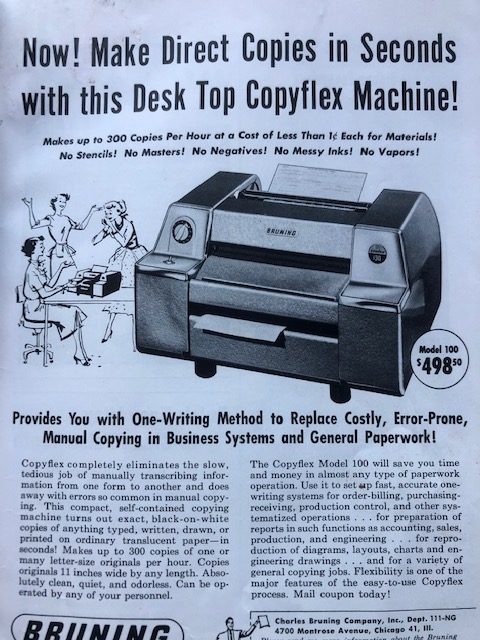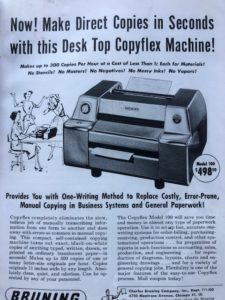

At my cottage in Minaki, Ontario, Canada this last weekend, I came across a November 1956 edition of National Geographic. What I found most interesting was not the articles but the ads.
I’ll highlight two.
The first is in the picture above. This Copyflex machine makes up to 300 copies per hour. That’s 5 per minute. And the price is “only” $498.50. Adjusted for inflation, that would be $5,430.55 today. Need I say more?
The second is an ad for long distance phone calls across the Atlantic. The fine print states that “The daytime rate for the first three minutes from anywhere in the United States is $12, not including the 10% federal excise tax.” $12 then would be $130.73 today.
There was one ad that did make me miss the good old days. It was for a beautiful Lincoln. I’m sure it was a substantial worse car than today, so my general point in the title holds. But car companies cannot legally make cars with the graceful lines of the 1957 Lincoln or, if they do, they would have to pay a huge CAFE fine. The regulators are more involved in dictating many aspects of cars than they were then. Without that regulation, our cars would be better than in 1957 and, in many ways, better than the 2022 cars, and there would be much more variety in car shapes.

READER COMMENTS
Oscar Cunningham
Jul 18 2022 at 7:29am
Doesn’t adjusting for inflation make it impossible to detect economic growth? If products such as these have gotten cheaper then other products must have gotten more expensive in order for inflation to have been what it was.
David Henderson
Jul 18 2022 at 9:03am
You ask:
No. Indeed, the standard way to measure economic growth is to adjust for inflation.
It’s possible that you’re getting at the fact that the CPI notoriously overestimates inflation and, therefore, understates economic growth and that one of the reasons is that it doesn’t adequately capture quality improvements, as in the Copyflex example. Is that what you’re getting at?
Jon Murphy
Jul 18 2022 at 7:52am
I love examples like this. I mean, just in my lifetime (33 years) I’ve seen communication change so much. When I was a kid, we couldn’t call Dad at work unless we absolutely had to because he worked in a different area code and that would incur charges. Fast forward just a few decades, and I was able to have a 2-hour video conference call with friends in Copenhagen, Florida, Texas, Arizona, and California without monetary cost.
Kevin Corcoran
Jul 18 2022 at 10:15am
It’s a similar story for me. When I was in high school, my best friend at the time technically lived in a different area code, even though he only lived a few miles away. That meant either of us calling the other constituted a “long distance call” which could become very expensive very quickly, particularly from the standpoint of our family budget. Nowadays, the idea that a ten minute phone call to someone who lives five miles away would be too expensive sounds unintelligible.
Speed
Jul 18 2022 at 8:11am
There were two 1957 Lincolns — the Lincoln which had hideous huge fins and the Lincoln Continental which was quite handsome.
As to graceful modern cars, the Jaguar F-Type for example, is quite graceful without a CAFE fine. There are others.
MarkW
Jul 20 2022 at 11:24am
CAFE doesn’t really affect modern car aesthetics — after all automakers continue to sell thirsty pickup trucks and large SUVs. What really impacts the shape of modern vehicles are safety regulations. One in particular is a requirement that there be sufficient space between the top of the engine and the hood of the car to cushion the impact of a pedestrian being thrown onto the hood.
Billy Kaubashine
Jul 18 2022 at 9:47am
Anybody have any explanation for why the inflation adjusted cost of automobiles and electronics took such dramatically different paths?
In 1977 my new 19″ color TV cost $300. My new 1977 Jeep CJ7 cost $4500.
Today, $300 gets me a bigger, better TV, but $4500 barely covers tax, title, and destination fee on a new Jeep.
Jon Leonard
Jul 18 2022 at 10:45am
Some of it is the automobile being older. The first car (Benz’s in 1886) apparently cost $1000, while the Model T was just $260. You can expect some early-on cost reductions as something moves to mass production. In the 1970s, this had already happened for automobiles, but not yet completely for computers. But a lot of it is CMOS technology being amazingly scalable. We had about 50 years where the trade-off was “You can make it smaller, but then it will be cheaper, run faster, and take less power.” It was also harder to build the plants to manufacture improved chips, but there was a surprisingly large amount of possible improvement, which leads fairly directly to modern computing equipment being relatively better and cheaper.
Billy Kaubashine
Jul 18 2022 at 7:30pm
Fair point. The manufacturing of automobiles had large productivity gains in earlier decades and perhaps hit diminishing returns.
But think of how much better off we would be today if productivity gains in production of automobiles …….and nuclear power plants ……. had at least kept pace with inflation.
Could regulatory creep, protectionism, and union rules have played a part?
Brian
Jul 18 2022 at 11:54am
Manufacturing shifted to lower cost countries mostly in Asia. More electronic components become integrated in a single package. In other words there are fewer discrete components to handle. When the linear dimension in an integrated circuit is reduced by 50% there will be 4 times the product yield ideally. Automated device placement and wave soldering eliminated much human effort. Manufacturers stopped wave soldering their own products and outsourced to contract manufacturers operating at a larger scale.
Matthias
Jul 28 2022 at 4:11am
The cost path of electronics is without equal, I’m afraid.
So the question isn’t so much why electronics and cars differ, but why electronics differ so much from everything else?
Bill
Jul 18 2022 at 10:56am
In 1988, through my “educator’s discount,” I bought a Macintosh SE with a dot matrix printer for $3500. The computer had 1 mg of Ram and a 20 mg hard drive. I believe the processor clock speed was 8 megahertz (or maybe it was kilohertz?)
Bill
Jul 18 2022 at 11:02am
I looked it up and it was 8 megahertz: https://everymac.com/systems/apple/mac_classic/specs/mac_se.html
Brian
Jul 18 2022 at 11:56am
But I still can’t type at 8 Megahertz.
KevinT
Jul 20 2022 at 2:54pm
This reminds me of two somewhat related anecdotes. My first PC in the mid-1980s was an AST machine with a monochrome EGA monitor, 10MB hard drive, and a price tag of something like $2500. I thought it was superb!
I’ll probably screw up this next anecdote, but… here goes. At that time, there was also a story going around of Bill Gates doing the rounds marketing his DOS operating system. At one users’ group meeting, he asked what Microsoft was most famous for. One wag in the audience shouted: “The 640K barrier.” Old geeks like me understand the reference.
Comments are closed.